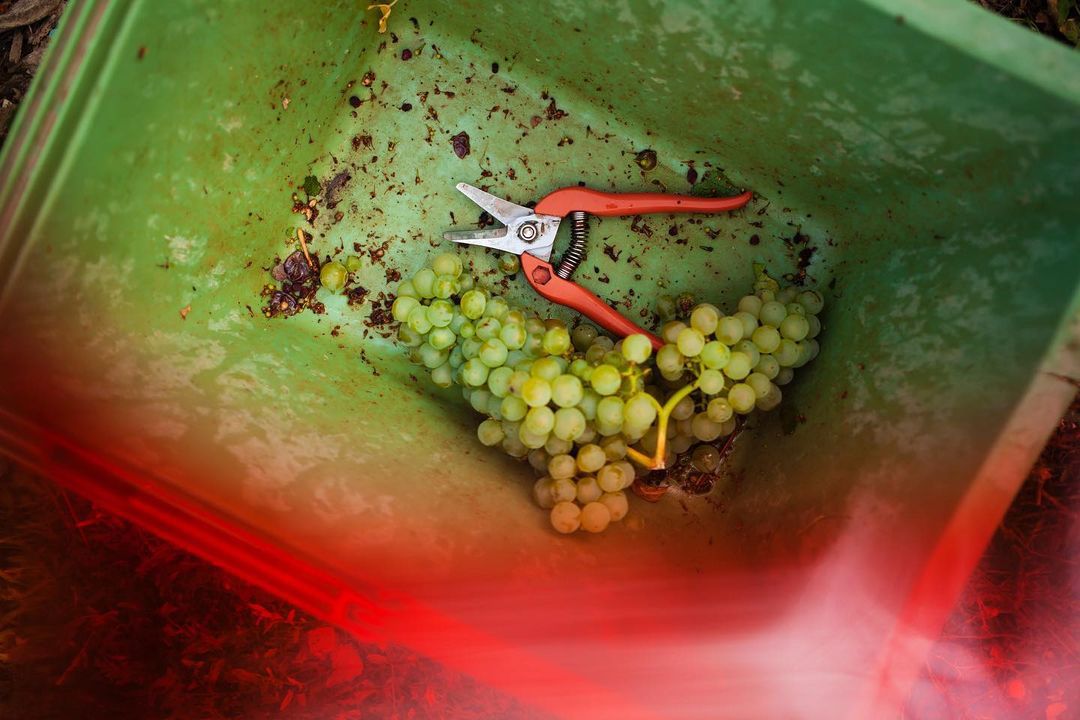“It is at an exciting point between the vivacity of youth and a more mature stage of evolution – quite frankly delicious and approachable now but auguring well for the next two decades of ageing,” Dean writes about the 2009.
It was inevitable that the launch of Dom Ruinart Blanc de Blancs 2009 on April 7, would have a sombre tinge to proceedings. Just hours earlier cellar master Frédéric Panaïotis had visited his vineyards to inspect what damage the devastating April frost had had on his vines.
“We had the cold spell two nights ago with damage to 10-30% buds,” he says showing us photos of browning buds, “that doesn’t mean how much we will be down at harvest… it is too early to tell the extent of the damage.”
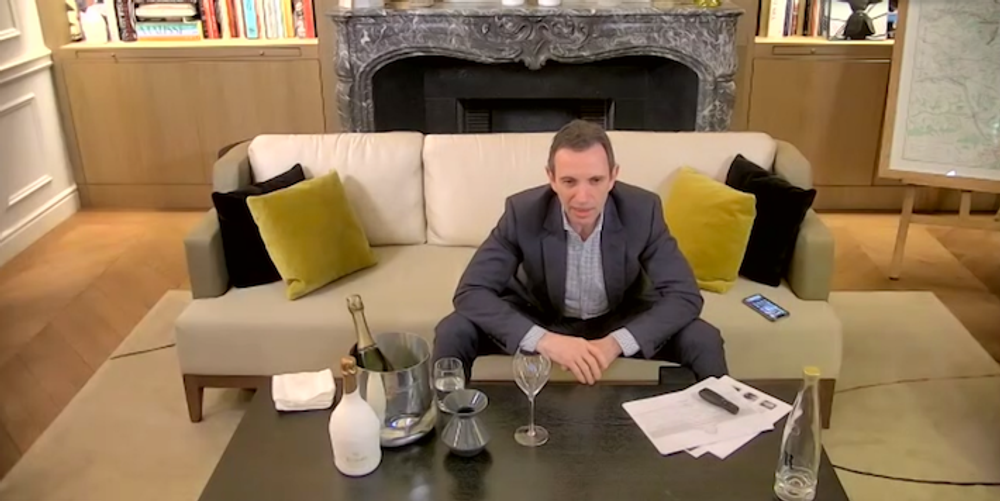
Frédéric Panaïotis at the UK launch of the Dom Ruinart Blanc de Blancs 2009
Even without the frost the night before, Panaïotis was prepared to do a deep dive into the effects of global warming – it being a central part of his pre-prepared presentation. The reason was that 2009 was a challenging year. The key distinguishing feature of the vintage was a very dry summer with 40% less rainfall than average; if you look at rainfall throughout the year, however, 2009 comes across as an average year but that was only because there were heavy rains in Spring (60% heavier than average), which were accompanied by gales, hail and cold snaps during the growth cycle.
Luckily the summer weather allowed for consistent ripening with the grapes reaching optimum physiological ripeness and the Dom Ruinart, harvest taking place between September 12thand 28th.
But September harvests are becoming a rarity, Panaïotis says. August harvests are increasingly becoming the norm with six starting in August between 2003 and 2020. If you look at the 50 preceding years there were no harvests in August, in fact many started in October.
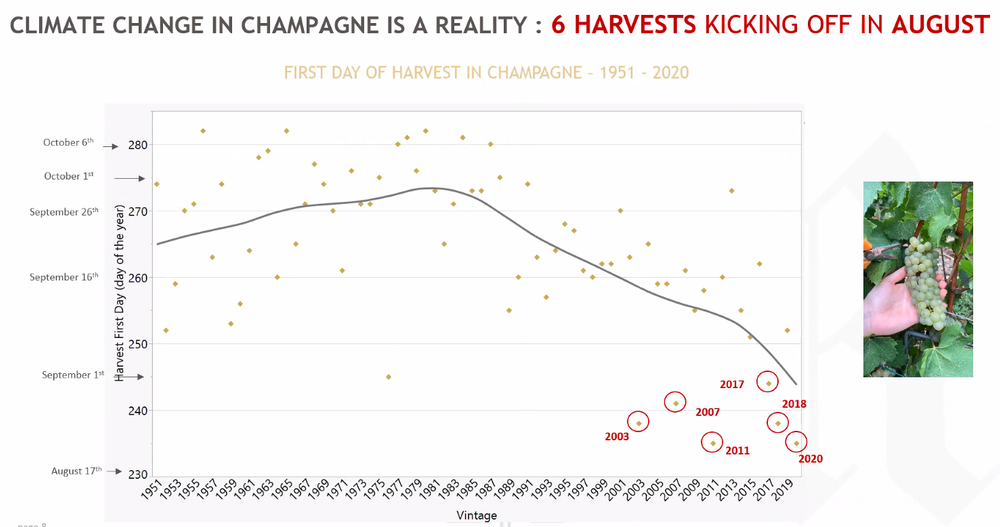
Earlier harvests, if handled skilfully, can facilitate riper grapes, but the real problem is the earlier bud break.
“The clearest sign of climate change is the warming with a minor winter which is more wet (this is OK in that it fills up water reserves) and spring is also warm,” says Panaïotis, “this is good in that it leads to mature grapes, but one of the consequences is early bud break – it was 25°C last week so for three to four days everything bursted and then today we have snow on the ground.”
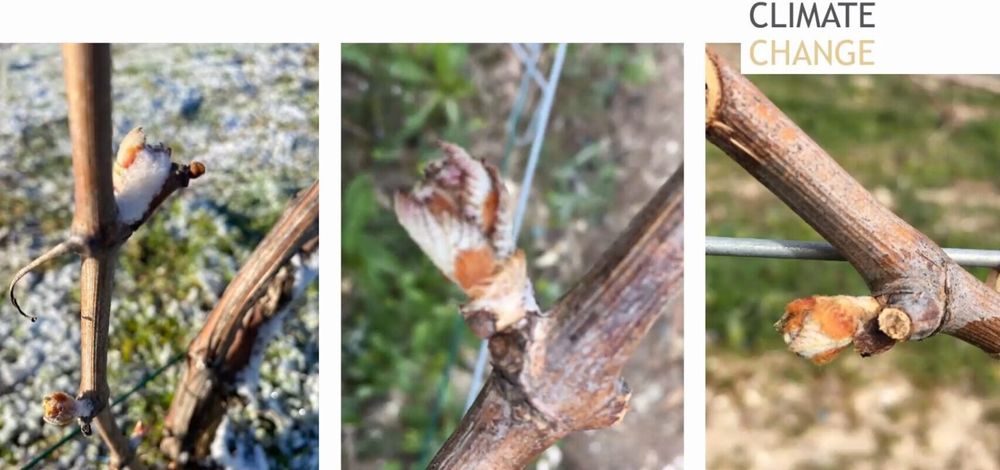
Burst buds hit by the frost, April 7 morning
Speaking of his most recent vintage, Panaïotis reports that 2020 was a very early year in terms of harvesting dates – starting on August the 15th, the earliest ever in fact – with a ‘stunning summer’ giving perfectly healthy conditions. Sugar levels in the fruit rise very fast in a hot year, so getting the balance right between freshness, ripeness and the right phenolics is not an easy task, but one which his team got just right in 2020 he believes.
Covid aside, that year completes what he refers to as ‘an incredible trilogy’ of 2018, 2019 and 2020 which he compares to the classic vintages 1988, 1989 and 1990. “I know you haven’t been able to visit and taste the vin clair but you’ll have to trust us on this one,” he says.
Putting aside the short term benefit of global warming aiding the ripening of Chardonnay in Champagne, Panaïotis says “But we are not wasting time any more,” referring to a recently launched biodiversity programme that has planting trees as its primary goal.
Another action Dom Ruinart is taking is to get rid of gift boxes on its luxury cuvées, with the ‘second skin’ packaging on the Non-Vintage cuvée a possibility for Dom Ruinart Blanc de Blancs 2010 which will be the next vintage of this wine released next year.
“The marketing team was looking at the packaging and we can’t go back – gift boxes are no longer possible – they are not something from the future. Some part of the population needs to be convinced, about what your own impact can be, so we need to speak more about it but it takes some effort and we are happy to be first to do this.”
50 years of Dom Ruinart vintage
Aside from the sobering subject of climate change, the release of Dom Ruinart Blanc de Blancs 2009 is actually a real cause for celebration as it marks the 50thanniversary of Dom Ruinart vintage. Not that anyone at the estate will be popping open a bottle of 1959, as there is only one left in their possession and even that was bought back from a collector.
The inaugural vintage was so meagre in volume that its entire production was exported to the United States in 1966, the year it was released onto the market. Bertrand Mure, then director of Ruinart, famously took out a full page advert in American newspapers ‘asking for forgiveness’ for only sending 1300 cases Stateside, before letting on that this was all that they actually made.
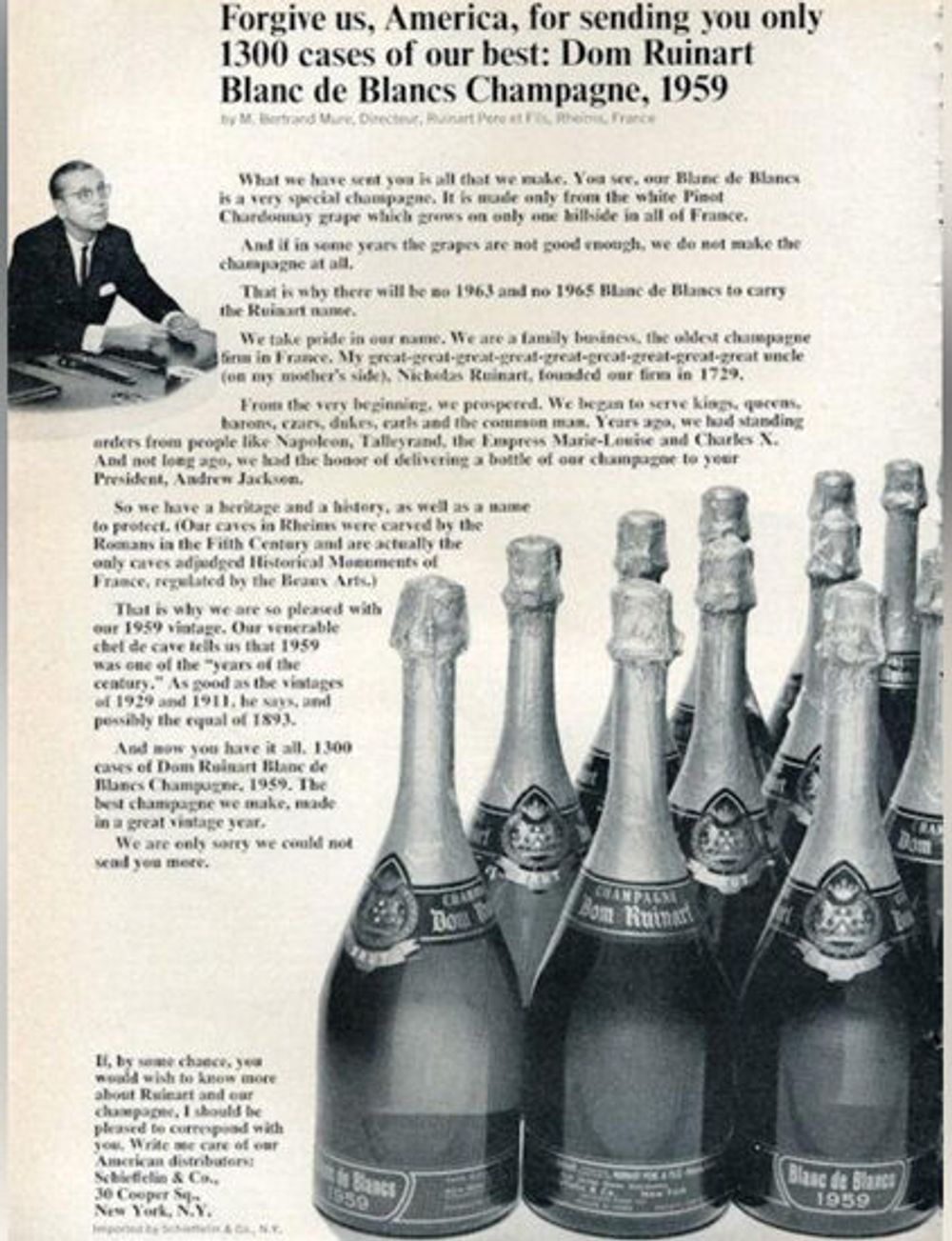
Smart marketing: how Dom Ruinart advertised the first vintage of its Blanc de Blancs
Since 1959 there have been just 26 vintages with no vintage made in 2008, a year that is generally referred to as a classic year in Champagne. The omission is interesting because it highlights one of the chef de cave’s decision-making.
What Panaïotis is looking for from his grapes is the point at which the Chardonnay expresses its complexity and elegance in full, whilst retaining extreme freshness.
“We didn’t make a 2008 the main reason being that we were not completely pleased with how the Chardonnay tasted – I think 08 was much better for black grapes – and I didn’t find it so exciting for Chardonnay. The Pinot Noirs were huge, the Meuniers amazing. On the other hand, we found a form of austerity on our Chardonnays. 2008 was like 1996 with super high acid to the point of being austere and aggressive – when we tasted the base wines – our perception at the time. We hesitated and finally let the 2008 millesime go.”
Another reason for skipping this vintage, he says, is that there is less pressure than in previous years on making a vintage every year possible. The opportunities to make a vintage are happening more frequently, and when there are good stocks of previous vintages in the cellar, he can afford to be more choosy.
“There are more possibilities than before to ‘craft’ vintages, previously if you missed a vintage the next good one would be two or three years down the road. But since 2000 we have been able to craft eight or nine vintages in just one decade. We also have 2002, 2004, 2006, 2007 in good quantities, there was no need to make a 2008, I was happy to skip it and here we go… we make 2009 ad 2010… je ne regrette rien.”
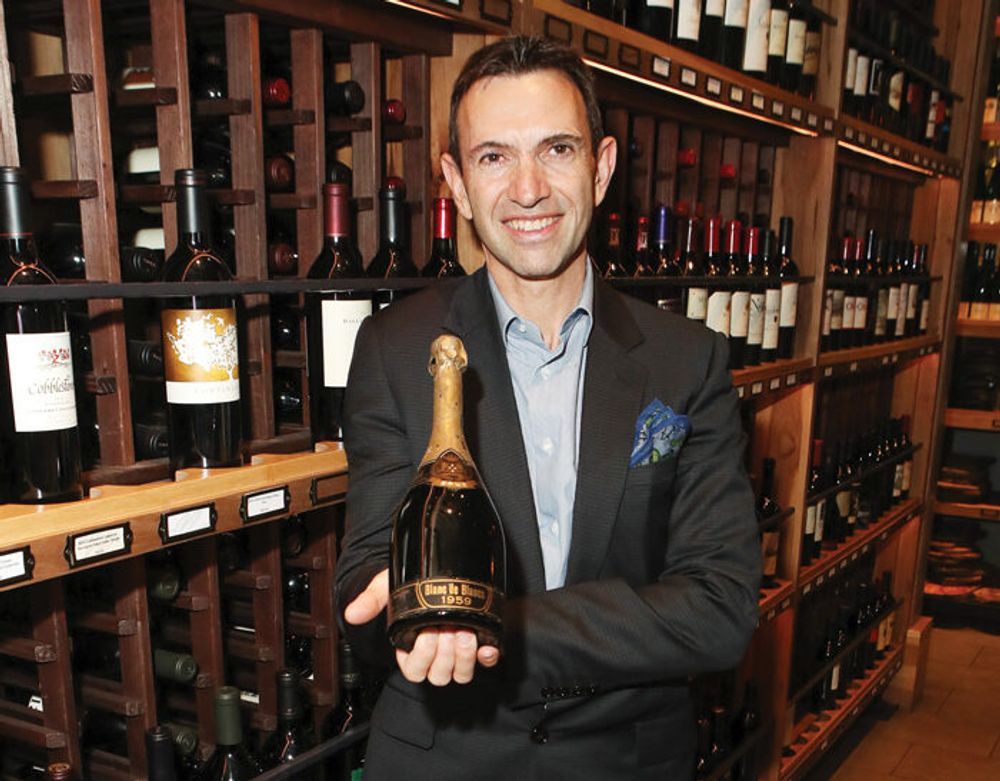
Frédéric Panaïotis holding the only known remaining bottle of the 1959 Blanc de Blancs
The composition of Dom Ruinart Blanc de Blancs 2009
With the help of diagrams, Panaïotis demonstrates how in terms of key indicators – annual average temperature, rainfall, sunshine hours, degree days, number of days between flowering and harvest, and summer average temperature – 2009 was not that unusual. The key difference was the lack of rainfall during the summer that has led some to describe it as a ‘solar’ vintage when he thinks it should more accurately be described as a ‘dry’ vintage.
The reason he is so keen on making this distinction is that a ‘solar’ year implies that the vintage was too warm which makes you think of lower acidity and less potential to age the wine, whereas the figures he shows ‘proves’ the balance in the wine.
The composition of the Dom Ruinart Blanc de Blancs 2009 is entirely made of Chardonnay Grans Crus, 82% from the Côte des Blancs (Cramant, Avize, Chouilly & Le Mesnil-sur-Oger) and 18% from the northern slope of the Montagne de Reims (Sillery). Normally the Montagne de Reims Chardonnay is about 30% of the final blend, but Panaïotis says he eschews a ‘recipe approach’ saying that the decision is made when assessing the tanks.
“ We pay attention to texture, the way the effervescence is integrated, (in 2009) it is not not tight, not linear like 2007, but has beautiful vivacity and freshness. Compared to 2007 and 2004, both were more linear and quite closed with a gunpowder flinty profile, whereas 2009 is more like 2002 – more floral, fruity, more open, liquid honey, pollen, it is already here in the wine which is not the case with 04 and 07 – 2009 already speaks in a playful way.”
In terms of vinification, fact lovers, it was a manual harvest, alcoholic fermentation in thermo-regulated stainless steel tanks, full malolactic fermentation (important for the wine’s roundness), aged for eight years on the lees with 4g/l dosage. The potential alcohol content was 10.1% with total acidity 7.5. The wine was disgorged in March 2018.
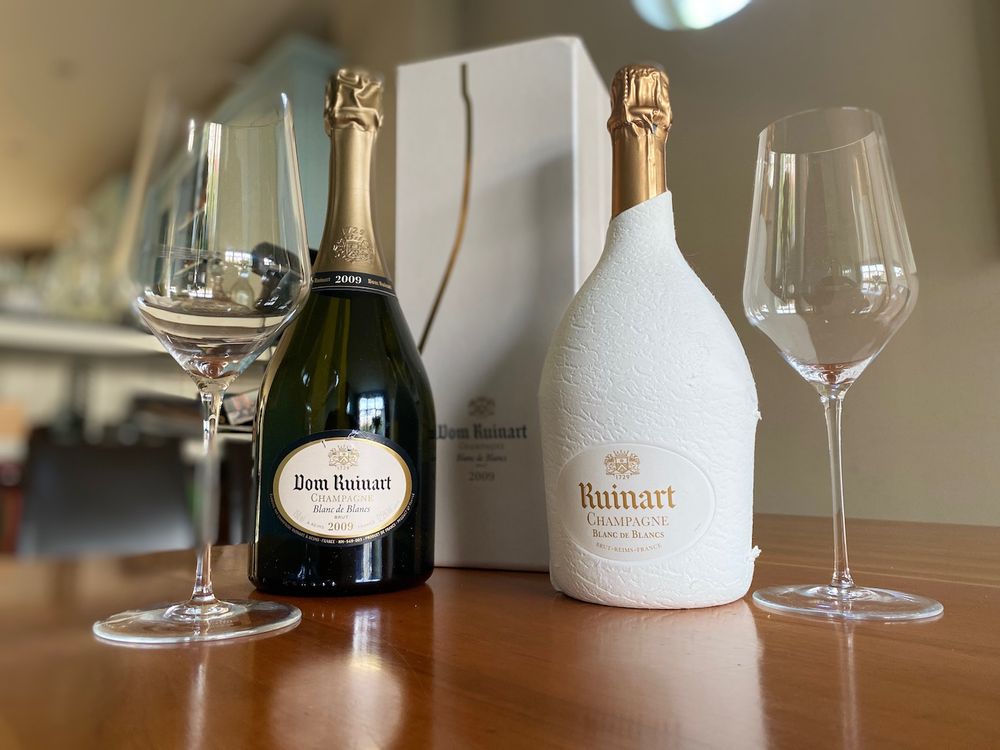
So how was it tasting?
The Dom Ruinart Blanc de Blancs 2009 is a ripe Blanc de Blancs that is finely balanced between showing off the generosity of the summer months but still retaining a steely freshness and elegance. It is at an exciting point between the vivacity of youth and a more mature stage of evolution – quite frankly delicious and approachable now but auguring well for the next two decades of ageing.
To look at the wine is a medium shiny gold, the bead steady and fine. The nose has bright floral notes, ripe stone fruit, honeyed with an attractive nuttiness – fresh almond, marzipan, a lift of Cream Soda also. The attack is bright, fresh, crisp, the mousse then more voluminous on the palate, finishing on a lean mineral note. The flavour profile is complex and detailed, all the time finely balanced between ripe orchard and stone fruit, lemon sorbet, and more nutty and baked components – nuts with Viennoiserie, a touch of rye crumb.
The wine opens out considerably in the glass and the next day shows off some more of its evolution. Impressive.
